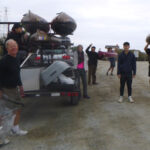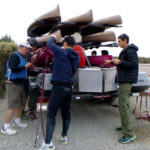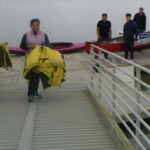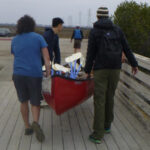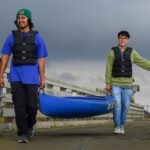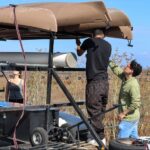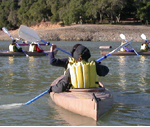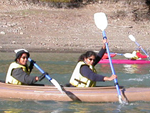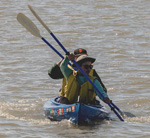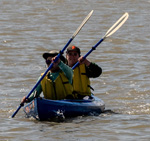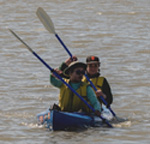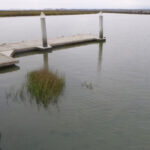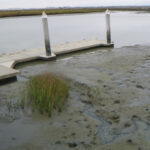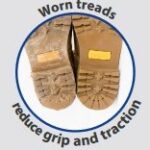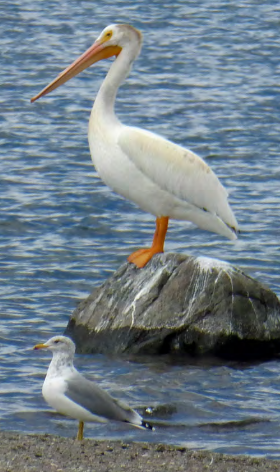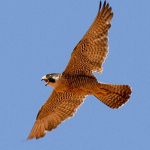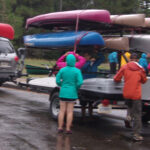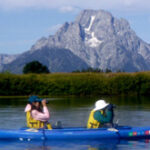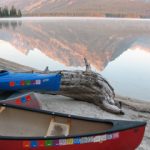kayaking lesson and practice paddling

beginners or experienced
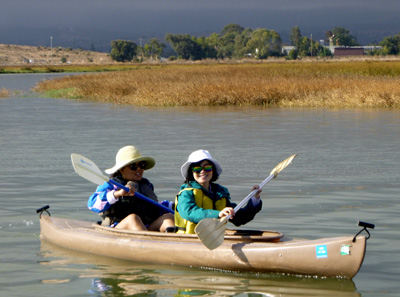
One of many impromptu races:
(most of the people you see in the picture below had never been kayaking before this)

“The 1,940-acre Baylands Preserve is one of the largest tracts of undisturbed marshland remaining in the San Francisco Bay.
Fifteen miles of multi-use trails provide access to a unique mixture of tidal and fresh water habitats.
Many consider this area to be one of the best bird watching areas on the west coast.
The preserve has a substantial resident population of birds as well as being a major migratory stopover on the Pacific Flyway.”
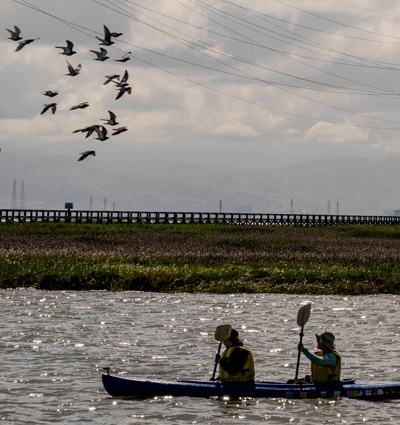



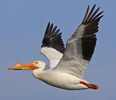

Baylands, in Palo Alto,
is about a 16 minute drive from the De Anza campus.
We do our paddling at the Sailing Station, launching off the dock shown in white on the map below
(the red X is to show the parking lot you go to, at the end of the road, next to the dock we launch from):
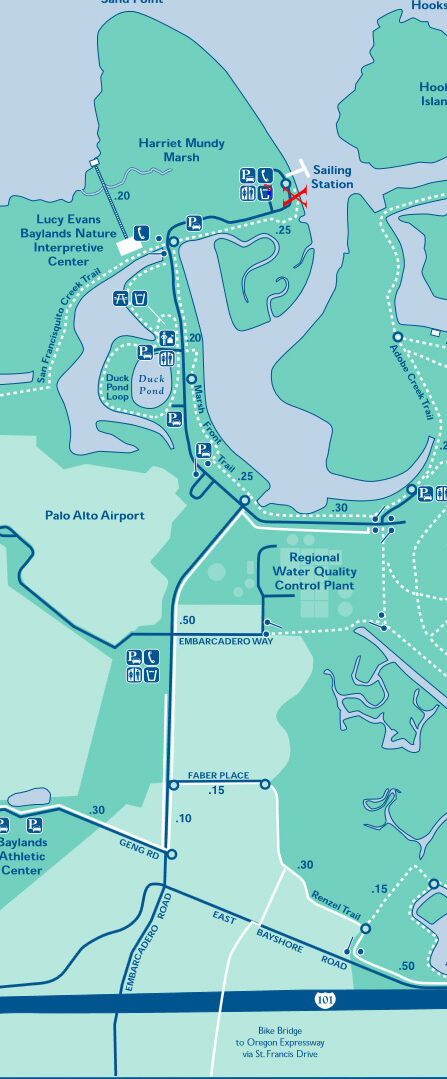
(Detailed driving directions are farther down at this webpage.)

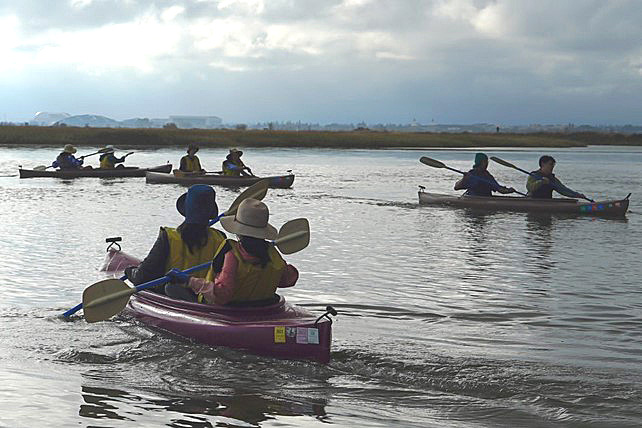
De Anza Outdoor Club has done a kayaking lesson and practice paddling
at Baylands (Sunday, 8 a.m.) Oct. 16, 2022, May 14, 2023 and Oct. 22, 2023, May 5, 2024 and October 13, 2024 , May 4, 2025 and Oct. 19, 2025.
(spring quarter) we are making plans to go again Sunday, May 17, 2026, 8 a.m.
(A local recreation company charges $149 – $169 for a kayaking lesson and tour.
Another company offers a lesson and paddling for $119 for “XYZ” Members, $149 for non-members.
Places in Monterey charge $40 per person for a kayak rental with no lesson.)
Cost
This lesson might be $35 club members, $45 other students. (Subject to change closer to our next trip.)
$15 of this will be totaled and split towards a credit for a future club event within one year.
The split will be based on time spent (especially among those who arrive on time) to unload kayaks,
put paddles together, bring the kayaks down the launch ramp
and among those who stay at the end of the event until all the chores are finished,
including, but not limited to,
bringing the boats/paddles/lifejackets back up the launch ramp to the trailer,
hosing off the paddles.
hosing off boats and reloading them, tying them down on the trailer,
repacking paddles and lifejackets.
There is no fee to enter the Baylands park and there is no charge for parking.
No kayaking experience is needed for this event.
The trip is designed for first timers, but people with experience kayaking also join us,
especially if they want to introduce friends to kayaking.
(Some students have done kayaking lessons with the Outdoor Club many times!)
You do not have to know how to swim
(even strong swimmers must wear a fully zipped lifejacket)
The club provides you a choice of small, medium or large lifejackets.
De Anza College Risk Management requires the use of the lifejackets, securely strapped / zippered, even for capable swimmers.
Some people at our kayaking practices put their lifejacket on inside out.
The guy on the left models a lifejacket with the straps that buckle shut on the inside,
the guy on the right has the same model of lifejacket on properly.
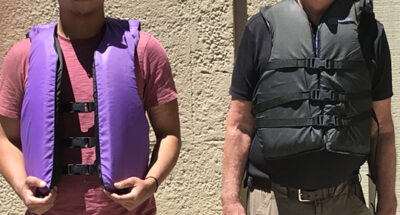
Sorry, no, there is not any place you can just come and watch the kayaking. The trail along the bay in view of where we kayak is too far way to hear what we are talking about, or even to see many details. You can’t be near the trailer when we are unloading or loading gear, and would be in the way when we carry the kayaks down the narrow launch ramp and get them in the water.
Carpools are arranged by individual students, not by the club or the college.
Only currently enrolled De Anza students, (part or full-time faculty, full time staff) can go on Outdoor Club events. Even though Foothill is in the same district, enrollment or employment at Foothill does not qualify anyone to go with us. People who want to go on an event between quarters (for example spring break or winter break) must have been enrolled the previous quarter, or already be enrolled in the following quarter. Faculty are subject to various rules depending on whether they are full time, ten month, part time, on sabbatical or Article 19 and should contact the club advisor well in advance of an event they want to participate in.
HOW TO SIGN UP
FOR THIS ADVENTURE
After you look through this webpage, please carefully read
the Bayland’s kayak lesson and practice paddling sample trip agreement
and then look at the How to sign up webpage.
For our kayaking lesson,
we use the kind of kayaks that your legs are NOT stuck in. For some models of covered kayaks that have your legs IN them, you would need to know how to do a “roll” and move your paddle underwater when you tip over.
The kayaks we use are like small canoes, for relatively flat water lake or reservoir use, not swift rivers or out in the ocean. (The model of kayaks we use do not tip over unless someone does something reeeeealy dangerous, such as trying to stand up in the kayak while on the water.)
The kayak seats can be adjusted forward and backward to accommodate people’s leg lengths.


The paddles, one shaft with blades at either end, will be adjusted for true kayak paddling with blades offset at right angles to each other
(see photo below of paddlers on Colter Bay during our Grand Teton trip between summer and fall quarter, using one of the same kayaks we use at Baylands). 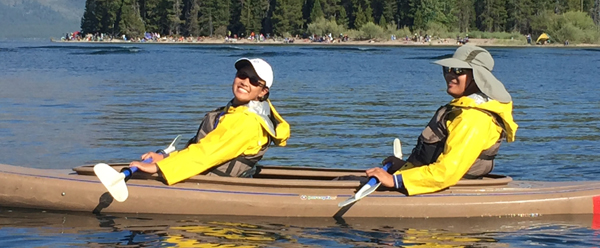
We always start with a practice using the paddles before we even go out on the water
(we can often use a vacant part of the parking lot). People find a partner and stand in front of each other (as if they were seated forward and back in a tandem – two person kayak) and try using their paddles, then switch places. :
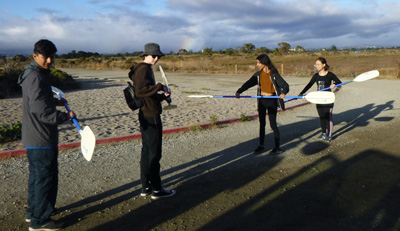

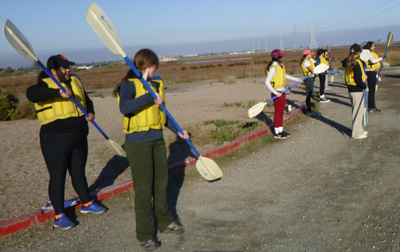
For most of our kayak touring and lessons we go 2 people per boat. Once people get used to paddling, they quickly figure out that if they can paddle simultaneously (both people pull their paddle blade through the water on the right hand side, then both people pull their paddle blade through the water on the on the left hand side), they will go faster (and then their paddle blades won’t bump against each other). It can work quite well to have the person in the front (bow) of the boat paddle, and the person in the rear (stern) tries to match them, dipping their paddle in the water and pulling through the water at the same time.
In the photo on the left below, the two kayakers have not yet figured out how to consistently paddle simultaneously,
in the photo on the right, the two paddlers are better at paddling simultaneously:
and these are able to go faster than when the lesson started because they figured out how to paddle simultaneously:
After we unload boats,
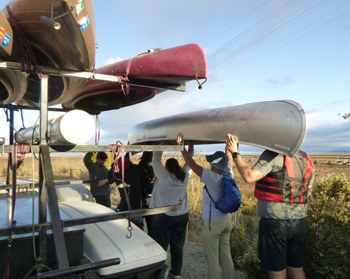
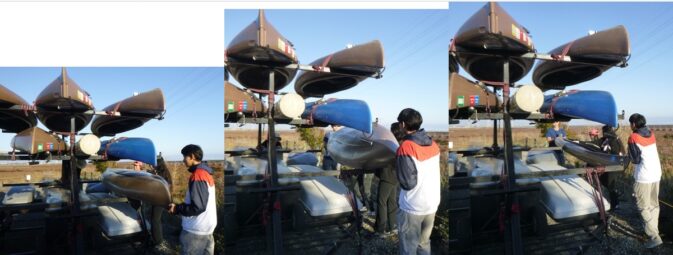
and get the lifejackets out of storage bins on the kayak trailer 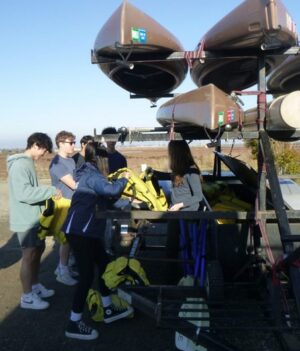
and fit them for people,
we carry the kayaks from the parking lot down the upper ramp
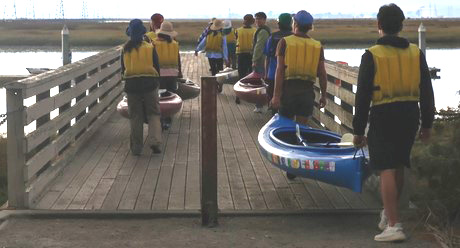
and line them up in a row on one side of the ramp, leaving space on the other side for other people to bring their craft back and forth:
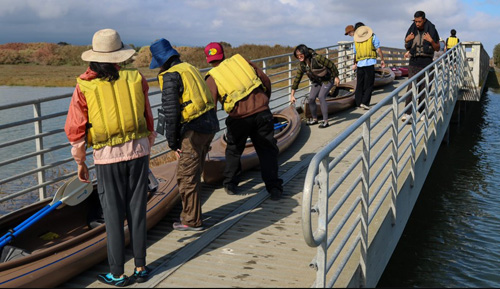
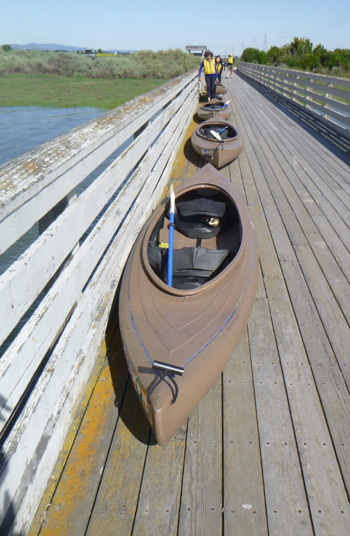 In the photo above you can see, at the end of the closest kayak, one of the built-in black plastic handles we carry them with. The seats in the kayaks are folded down at this point so the paddles fit in and won’t slide out as they are being carried.
In the photo above you can see, at the end of the closest kayak, one of the built-in black plastic handles we carry them with. The seats in the kayaks are folded down at this point so the paddles fit in and won’t slide out as they are being carried.
Once all the kayaks are lined up on the upper ramp, we start bringing them down to the lower ramp /dock to launch them
(a few at a time so we don’t take up all the space on the lower ramp / dock and other people will be able to find space to launch).
We place each kayak on the lower dock with the bow (front end) facing out towards the part of the bay we will paddle in, set the paddles on the dock, fold the seat backs up into position, and a minimum two people lift them down to the water:
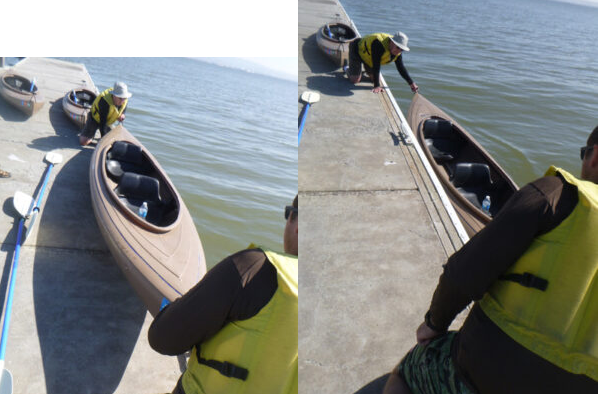
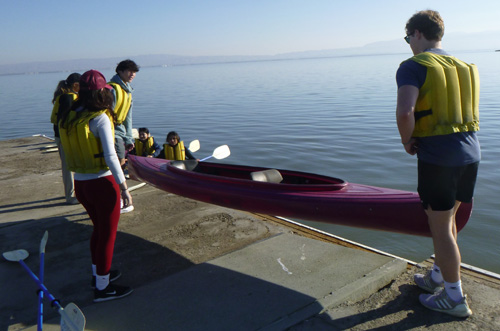
One at a time, the two people who will paddle a tandem kayak get into the boat.
No one should ever stand up in a kayak and there is no reason to, either to be able to get in or out of the kayak.
We make sure there is at least one person on the dock holding on to an end of the kayak, while paddlers get in, and the first paddler in can hold on to the dock to steady the boat:
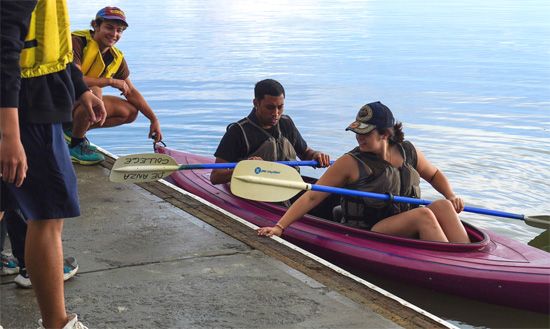
Or sometimes there are two people on the dock holding on to the handle at each end of the kayak to keep it next to the dock and as stable as possible, as shown below.
Here is one method
of getting from the dock into a kayak
(see below for a second way)
Each person getting into the kayak starts by keeping all their weight on the dock (either on one foot or on their knee), gets one foot into the boat, gets one hand on the far side / edge of the kayak, then shifts their weight and sits down into the boat. We give detailed instructions before people try this and as they do it. (To sign up for this trip you will need to certify that you are fully capable of participating in this activity without assistance, including being able to stand on a dock and get into a kayak in the water that is moving at least some and then getting out of the kayak and back to the dock.)
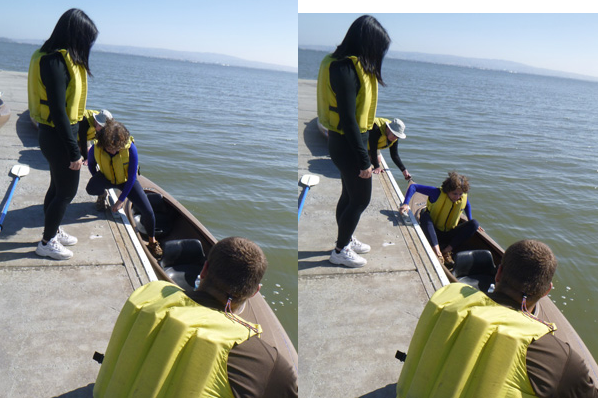
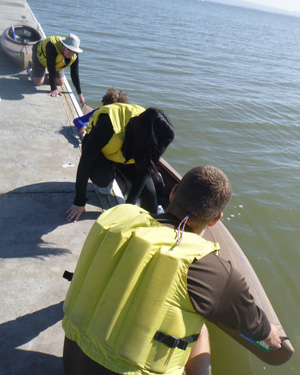
We can slide the kayaks in the water along the edge of the dock so that the first person who got in can easily hold on to one of the large metal cleats at the edge of the dock to help steady the boat while the second kayaker gets in:
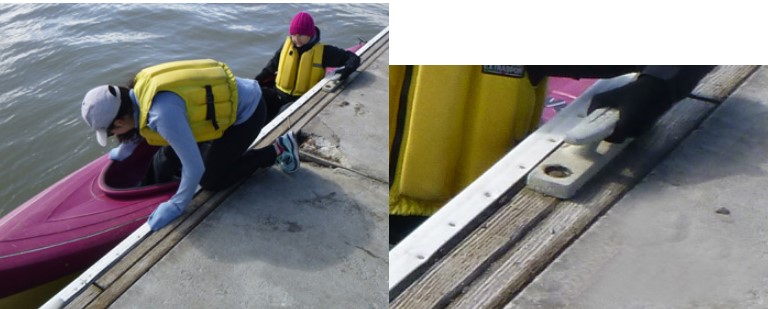
OR, another way to get into a kayak from the dock,
again with other kayakers holding the ends of your boat to keep it close in to the dock,
You can sit on the dock and put your feet in the kayak,
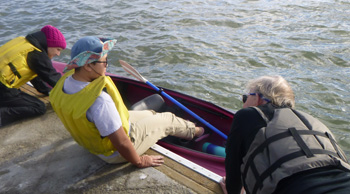
then shift your weight a little
(reach across to put one hand on the far side of the kayak),
and hold on as you sit down in the kayak seat.

Sometimes, especially with a small group and with no other group using the dock at the same time as us, we have everyone wait, holding on to the dock, until the entire group is in their kayaks.
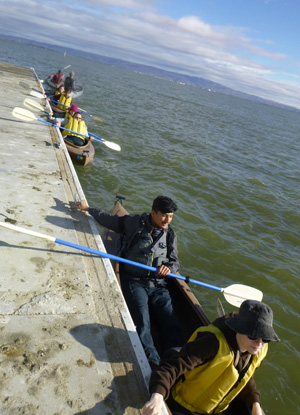
If we let people launch as soon as they get into their boats, the first to launch need to stay in close vicinity of the dock until everyone is launched.
Here, kayakers are departing the Baylands dock:



In May 2023 we shared the bay we paddle in with a standup paddleboarder:


The section of the bay we paddle in is away from boat traffic, and the slough is wide enough,
(at high tide) for plenty of room to practice paddling.
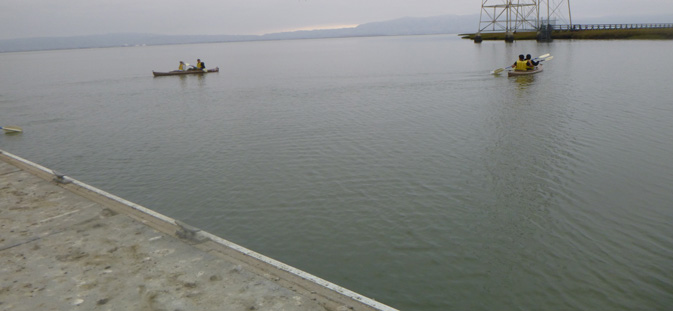
When you walk out on the dock and look to the right, you can see some of the slough where the water gets shallower, to the right hand side of this photo. (We will not go that far).
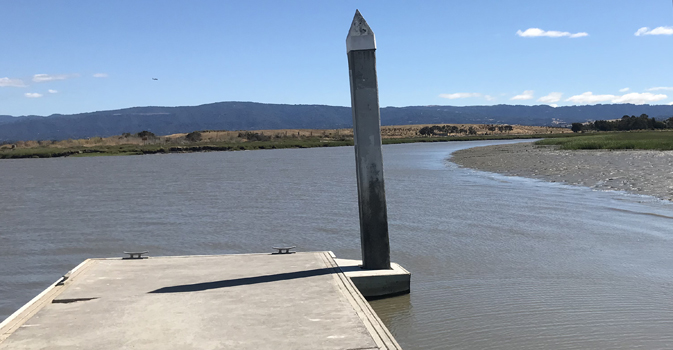
When people get accomplished at two two paddlers matching their paddling strokes,
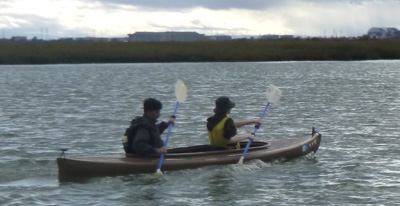
they can try fast paddling,

try paddling a figure eight,
can try paddling backwards,
and experiment with one person paddling right and left and the other paddling only on one side
to get a feel for handing this type / size of kayak.

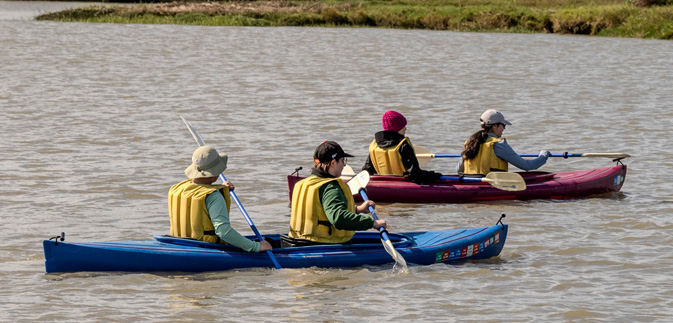
After some paddling, people sometimes go back to the dock and trade positions in their tandem kayak or try paddling with a new partner:


and try more (optional) racing:

People figure out fairly quickly how to paddle, but setting up a group photo can require a lot of boats bumping together and giggling:
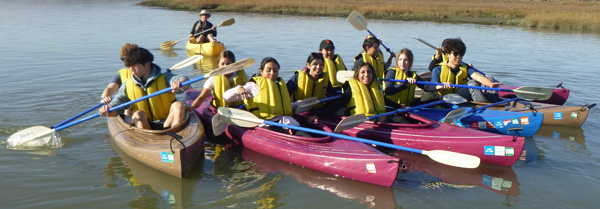
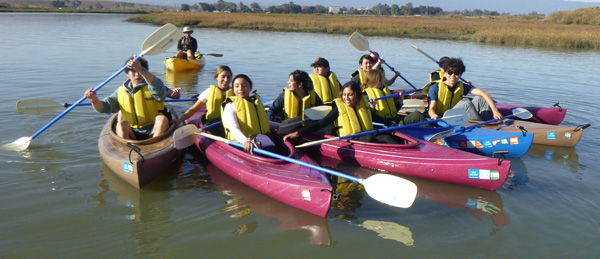

When we return from our kayaking, one person in a boat can push another person’s boat to hold it to the dock edge while the occupant climbs out (as seen at the top of the picture below). Usually we choose someone experienced at it to be the first person to get out of their boat back on the dock, so they can then help others.
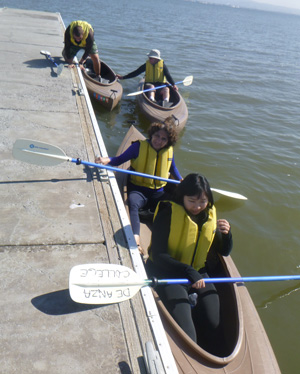
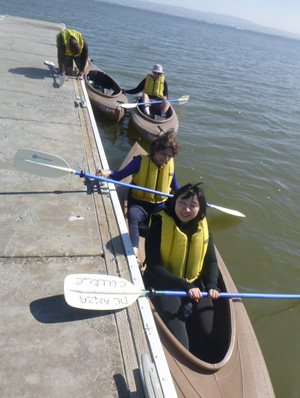
Putting the paddles into the kayaks makes it easier to transport them back up the ramp to the kayak trailer instead of trying to hand carry the paddles:
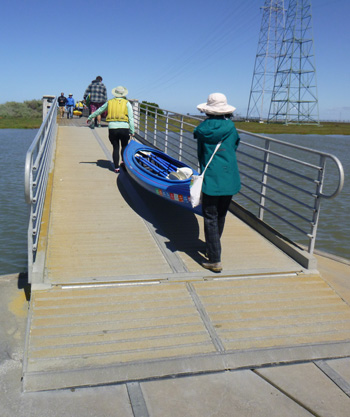
Interesting weather does not cancel Outdoor Club events
(except we do not paddle in lightning storms).
On the October 2023 trip we had cloudy/sunny weather almost all morning, with a few sprinkles on and off at the end as we were reloading the kayaks on the trailer. After everyone was packed up and departing it rained and then opened up with a huge downpour.
When bringing the kayaks back up the ramp to the trailer in October 2023, we saw the biggest rainbow of the day:
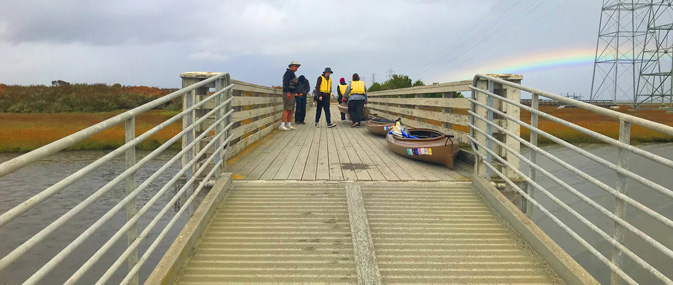
To get kayaks back on the trailer, one person can hold onto one of the built-in black plastic handles at the front end of a kayak, while another holds onto the built-in black plastic handle at the rear end, then they lift. When they get it up off the ground, others can come closer and help turn it over, then everyone can set it down on the trailer rack:
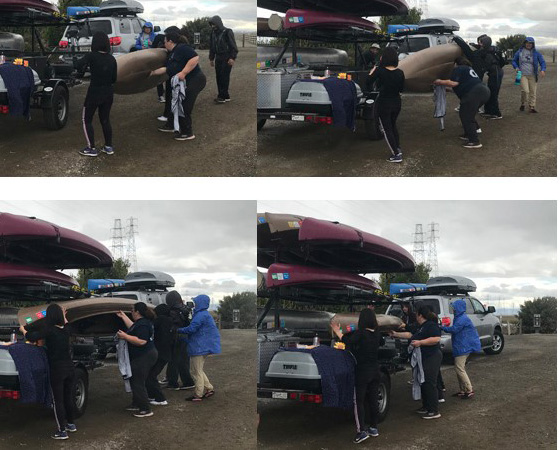
One strong person might be capable of doing this by themself, but for safety,
we require at least two people for each kayak as it is moved.
——————————————————————-
Why do we always go so early in the morning? (8 a.m.)
On a windy afternoon you might see sailboarders, as at the left on the bay beyond the dock:
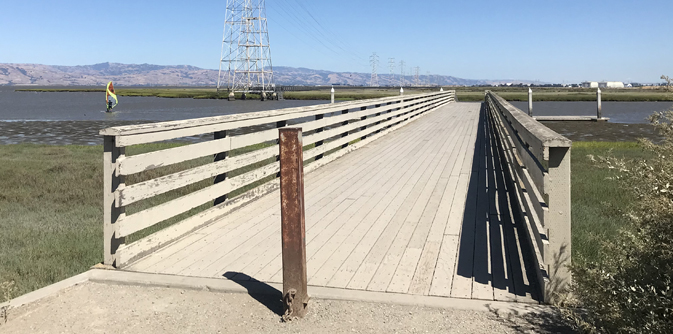
And that afternoon wind is why we aim for an early morning adventure when we can also expect lots of parking spaces available in the (free) parking lot next to the dock we launch from.
We also need to aim for a high tide.
Below see the water level around the dock we launch from, with plenty of water at high tide, and lots of mud at low tide:
——————————————————————-
The club provides all the kayaks, paddles, lifejackets.
You should bring: Chapstick,
good waterproof sunscreen (remember to put some on on top of your legs if they are bare),
unbreakable water bottle
(especially to be able to rinse salt water out of your mouth if you end up in the bay – which is not likely),
sunglasses and croakies or other eyewear retainers,
hat with a brim to keep sun out of your eyes,
windbreaker, long sleeve polypropylene and/or other warm sweater.
A waterproof hooded rain jacket, for if we get sprinkles/rain and which helps you stay warmer if it gets windy. (A waterproof hooded rain jacket and rain pants, not just a poncho, are required for everyone going on one of our trips to Grand Teton National Park or Yosemite National Park.)
Possibly towel(s), change of clothes and shoes for afterwards in case you get wet.
Maybe gloves or mittens and a knit hat (or even a swim cap) to put on to stay warmer.
You could bring your bike for after our kayaking, as there are miles of bike paths.
Wear:
-Lifejacket (provided and required: you must wear it all the time, and it must stay zipped).
If you have a favorite lifejacket, feel free to bring it.
Wear loose clothes you can easily move your arms and bend your legs in.
On your feet: closed-toed shoes with enough tread left on the bottoms and enough ankle support that you can help carry the kayak you will use. Example: tennis shoes that can get wet. NO sandals, flip flops, open-toed, or open-topped shoes, even with socks on.
Be sure to take car keys and things out of your pockets so you won’t lose them in the slough.
There might be a limited number of drybags to keep gear relatively safe, one-per-boat, not one-per-person. Lots of people bring binoculars or cameras, but there is some risk of getting them wet, or even losing them. Some people bring a waterproof disposable camera and small water bottle in a fanny pack.
DO NOT BRING:
your own boat or stand-up-paddle-board, racing kayak, anything rigged for sailing, swamp buggy, inflatable craft, anything motorized, etc.
Dogs, pets (even in that doggie-lifejacket and no, you can’t leave it leashed to the kayak trailer and should not leave one in your vehicle while we are out paddling).
– – Vehicles with excessively loud exhaust systems disturb nesting birds and other wildlife and are not allowed on De Anza Outdoor Club trips. This can include a muffler that needs repair or an after-market one advertised, for example, to deliver “loud sound both during idle and acceleration . . . a deep and aggressive exhaust note suitable for enthusiasts who love the loud sound . . . powerful, classic muscle car sound.”
——————————————————————-
We won’t likely see Bat Rays, (but they might splash water at the surface),
and people must not poke in the mud trying to find them:
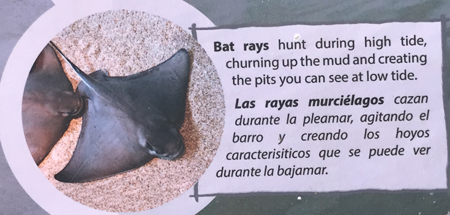
A trip member saw 2 bunnies hop out of a bunch of bushes, run across the parking lot next to the dock we launch from and into another bunch of shrubbery.
People have watched a Tern hover with wing beats like a hummingbird and then dive down into the water to get a fish.
On a May trip we saw at least 30 sparrows flying back and forth along the surface of the water near us catching bugs.
We have seen flocks of Pelicans, sometimes 25 to 50 or more, flying overhead in a V shape or a wavering line. Their size is difficult to judge from below them, but they have a wingspan of 8 or more feet, wider tip-of-wing to tip-of-wing than the humans watching them are tall.




and always there are seagulls:

Here a photo showing the size difference between a pelican and a seagull:

Audubon Society Birding Guide to Palo Alto Baylands
https://scvas.org/self-guided-birding/palo-alto-baylands-spring
includes:
“Birding at the Palo Alto Baylands is easy and convenient. Saltwater, brackish water, and freshwater, along with a diversity of trees, bushes, and native plants provide habitat for an abundance of sightings and behaviors by no less than 50+ bird species including shorebirds, waders, passerines, raptors, ducks, geese, not to mention gulls… ”

The birding guide has pictures and descriptions of these birds:
“As you walk along the boardwalk keep an eye out for raptors, both in the air and perched on the electrical towers. Possibilities include Red-tailed Hawks, White-tailed Kites, Turkey Vultures, and Peregrine Falcons, possibly even a Bald Eagle. Lower, flying directly over the marsh, Northern Harriers scan the pickleweed for prey . . . you may spot Great and Snowy Egrets, and Great Blue Herons, while being serenaded by Song Sparrows . . . Harriet Mundy Marsh: Black-necked Stilts and American Avocets nest here in spring and summer months. Greater Yellowlegs, Great and Snowy Egrets, Great Blue Heron, and Killdeer frequent here. In the distance note how Common Ravens may use electrical towers for nests . . . lagoon: Western and occasionally Clark’s Grebes can be seen here as well as Least Sandpipers, lingering winter migratory ducks, and year round Mallards and Ruddy Ducks . . . In spring and staying through the summer Bullock’s Orioles, and Mourning and Eurasian Collared-Doves may be spotted here. Anna’s Hummingbirds, year-round residences . . . Common Yellowthroat . . . Palo Alto Duck Pond: During the summer a few American White Pelicans and Double-crested Cormorants might visit the pond. Pied-billed Grebes nest in the area and you may see their young here and it’s a good place to spot Snowy Egrets and Black-crowned Night-Herons . . . American Avocets can be spotted, feeding in the mud. Long-billed Curlews, Willets, American Coots, Black-necked Stilts, and Killdeer may be spotted as well.
Three photos of Peregrine Falcons:

Preserve rules include:
There are areas that are off-limits, including right next to the parking lot we meet at:
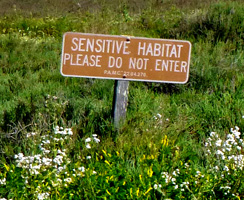
15 mph speed limit on park roads.
No collecting of plants or animals.
No feeding animals, ducks, birds.
Because planes landing at the Palo Alto airport fly nearby, no kites or drones.
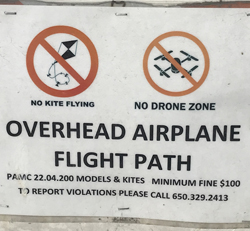
Here, a plane coming in for a landing as seen from the dock:

![]()
Driving Directions:
(CSAA says it is 12.3 miles / 16 minutes from De Anza College to the preserve.)
There is no fee to enter the Baylands park and there is no charge for parking.
From De Anza College take 85 north to 101, then 101 north. Once you are in Palo Alto, from Highway 101 take the Embarcadero Road/Oregon Expressway exit, (exit 402).
Do not go on Oregon Expressway, but further up the exit road, turn east onto Embarcadero Road.
You will go past a golf links and the Palo Alto airport on your left.
The road will narrow to 2 lanes as it reaches the park boundary.

You make a left at the stop sign, which is the red X at the bottom of the map below
and continue on into the Preserve on Embarcadero Road
until it ends at the boat launch parking lot (large red X at the top on the map below).
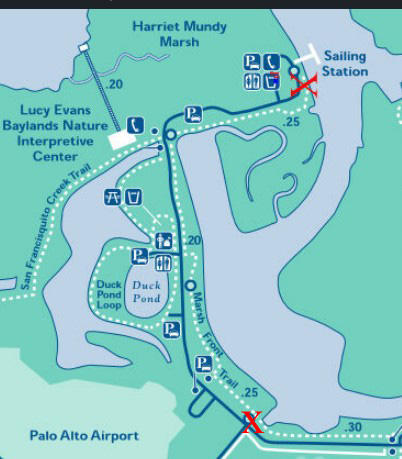
and here is an aerial photo (taken at high tide) of the parking lot on the left, and the dock we launch from and the area we paddle in on the center and right:
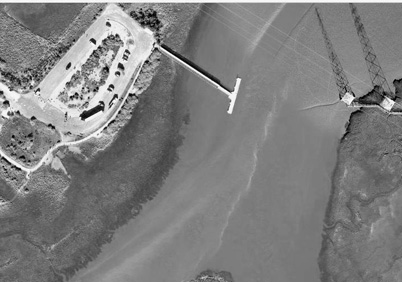
The kayak trailer might be at the far end of the parking lot before you get there:
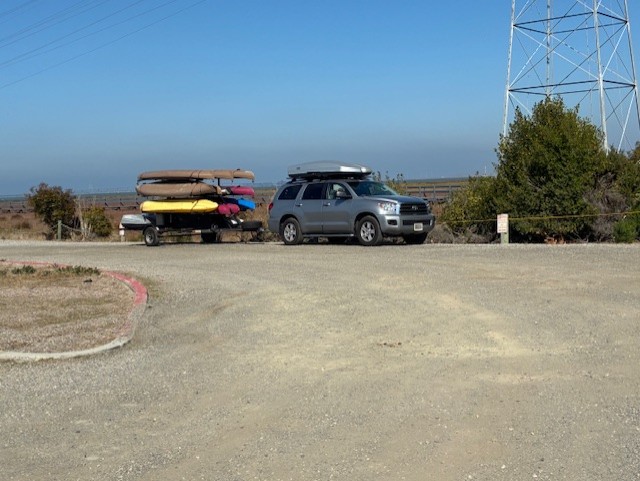
“One portable, unisex ADA-accessible restroom is located in the parking lot.
Other restrooms are located throughout the Preserve.”
The 15 mph speed limit (or even slower) is especially important to follow in the dirt and gravel parking lot where we meet, to not stir up as much dust into the air.
and see this view of the parking lot at a Google Maps page.
![]()
These kayaks are also used on the between-summer-and-fall-quarter trip to Grand Teton National park,
Grand Tetons kayaking

Going kayaking at sunrise on the Grand Teton National Park trip requires getting up while it is still dark to hook up the kayak trailer for towing:
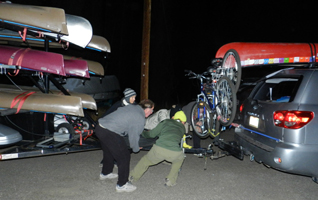
(Links to all Outdoor Club Coming Attractions are here.)
and also perhaps of interest:
Road trip advice and etiquette
Why you should wear a lifejacket.
below a Mallard and duckling that you might see on this trip, or on the Yosemite Trip or the trip to Grand Teton National Park:
![]()
At Baylands we paddle in calm, flat water, with NO boat traffic to try to get through,
as in the photo below of a different kayaking venue we have tried before:

We do not launch or come back through waves,
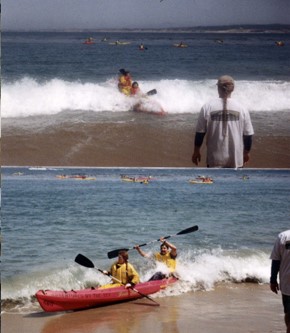
If you choose to rent a kayak in Monterey you can expect (depending on the outfitter you choose) wet launches and landings.
The author of this webpage, (written for my students), does not give any warranty, expressed or implied, nor assume any legal liability or responsibility for the accuracy, completeness, or usefulness of any information, product, or process included in this website or at websites linked to or from it. Users of information from this website assume all liability arising from such use.

